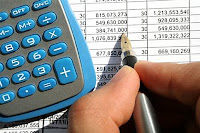
Today we will be working through the creation of a personal budget spreadsheet. We will use it to keep track of income and spending, and use it to plan purchases, investing, etc.
Do this as realistically as possible as if you were moving out on your own [if you aren't already living on your own] and assume you have a real job and are living in a real house or apartment:
INCOME:
- Income 1
- Income 2
- TOTAL INCOME:
EXPENSES:
- Housing/Rent
- Food
- Car Payment
- Car Insurance
- Travel (Gas, Bridge Tolls, Bus, etc.)
- Utilities (Gas, Electric, Propane, etc.)
- Phone (Home / Cell)
- Internet
- Cable / Satellite TV
- Health Care / Medicine
- Clothing
- Entertainment
- Pets
- Sundries (Toilet Paper, Soap, Laundry Detergent, etc.)
- Furnishings / Kitchenware / Appliances
- School Expenses
- Credit Card Payments
- Child Care
- Savings
- Laundry
- Snacks (Energy Drinks, Candy, Soda, etc.)
- TOTAL EXPENSES:
Obviously you [
hopefully] won't have all of these expenses, but for now go ahead and set the spreadsheet up with them in. When we are finished we will take out items that we KNOW we will never use. I will
never need a "tobacco budget", for example.

After laying out the income and expenses in the first column (A), create columns for each month of the year (B) through (M). Next, create a "TOTALS" column (N).
Work on formatting your document by bolding and centering the headers, adjusting font styles, right-aligning the incomes and expenses, adding color, etc.
Finally, begin entering your first months data.
If you're having trouble understanding the coordinates in Excel, try to think of them like a Battleship game:
In this example, the boat that has been hit is at cell E7. The boat in the bottom-right corner is at cell J10.
 |
| Rows are horizontal... like the rows of a theater. And they are numbered -- row 3, row 4, etc. |
 |
| Columns are vertical... like columns in a building. They are lettered -- column A, B, C, etc. |
.jpg)





